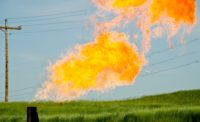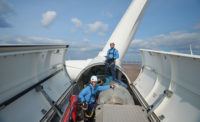A new study by University of Michigan researchers published in the academic journal Science suggests that flaring at U.S. oil and gas facilities releases five times more methane than previously estimated—with unburned, escaped gas making up as much as 10% of the country’s petroleum-based emissions.
The results, based on research in three major U.S. natural gas producing regions, examined longstanding industry and regulatory assumptions that flares are lit consistently and that they burn off 98% of methane when in operation.
Methane, a greenhouse gas, could be even more pernicious than carbon dioxide, environmental advocates say. According to the Environmental Defense Fund, it contributes 80 times more to global warming than CO2 for the first 20 years after its release into the atmosphere.
The assessments were conducted using aircraft equipped with air-monitoring equipment that measured the volume of methane released from facilities during 13 flights in the Permian and Eagle Ford oil and gas fields in Texas and in the Bakken oil and gas field in North Dakota—where more than 80% of U.S. flaring operations are located.
According to the researchers, the flares were unlit about 3% to 5% of the time, while those that were active were found operating at low efficiency. This resulted in an average effective flaring efficiency rate of only 91%.
Planes flew downwind of flaring sites—crisscrossing the direct pathways of air plumes released by flaring. Tubes and pumps drew air into onboard instrumentation, where laser scanning at a specific frequency measured the amount of CO2 and methane the air carried. Measuring both gasses simultaneously allowed researchers to estimate the destruction-removal efficiency of flaring at an individual site.
“With management practices and our better understanding of what’s happening to these flares, we can reduce this source of methane in a tangible way,” Genevieve Plant, the study’s lead author, said in a statement.
Industry Response
The petroleum industry contends that reducing methane emissions from flaring is already a priority. A recently published report from the Environmental Partnership, made up of 100 firms representing 70% of the U.S. onshore natural gas and oil industry, found that over the past year, application of best operating practices and new technologies had reduced participating companies’ flare intensity by 45%, with total flare volumes cut by 26%.
The report also noted that the number of companies participating in the flare management program increased by 40% during that period.
These results “show the steadfast commitment by the industry to meet energy needs while at the same time being good stewards of our environment,” Todd Staples, president of the Texas Oil & Gas Association, said in a statement.
With an American Petroleum Institute executive saying that there are additional studies reflecting flare efficiency at or above 98%, “research into the specific causes and conditions of [lower] efficiency is a valuable area of further study.” The exec added in comments to ENR, “API member companies recognize this opportunity for improvement and support actionable data.”
Environmental groups such as the Environmental Defense Fund, a partner in the University of Michigan flaring study, argue that more can be done, particularly since the United Nations has identified methane reduction as critical to slowing climate change over the next quarter century.
Although the Biden administration’s Methane Emissions Action Plan, announced last November, includes efforts to address venting and flaring of methane from oil and gas operations, “the U.S. Environmental Protection Agency and Bureau of Land Management should implement solutions that can help end the practice of routine flaring,” Jon Goldstein, EDF's senior director of regulatory and legislative affairs, said in a statement.
Europe Probes Nord Stream Leaks
Meanwhile, methane leaks from the Russia-operated Nord Stream 1 and 2 natural gas pipelines in the Baltic Sea near Sweden and Denmark have been under investigation for possible sabotage, following three still-unexplained Sept. 27 explosions.
Probes by Sweden's Security Service on Oct. 6 found evidence of detonations that caused major pipeline damage, boosting suspicions of "gross sabotage," said the agency, which referred to its activity as a "crime scene investigation."
In media reports, Russian and U.S. officials each denied involvement in the detonations.
Flyovers on Oct. 3 by Sweden’s Coast Guard, which also dispatched a submarine rescue and diving vessel to the rupture site, had reported that while the Nord Stream 1 leak was no longer visible, the smaller one from Nord Stream 2 had expanded slightly to about 30 meters in dia.
The pipelines are at a depth of about 70 to 80 meters, officials said.
Switzerland-based operator Nord Stream AG estimated the three-pipeline system, while not in operation when the explosions occurred, contained a total of 778 million standard cu m of natural gas. The Danish Energy Agency estimated a worst-case leakage of 14.6 million tons of CO2-equivalent (CO2e) greenhouse gas emissions.
In an Oct. 6 statement, the European Space Agency said that according to satellite monitoring, "the estimated emission rate derived from its first methane concentration measurement was 79,000 kg per hour – making it the largest methane leak ever detected ... from a single point-source."
Even so, such a release to the atmosphere would equal about 0.1% of the world’s estimated annual methane emissions, according to the U.S. Geological Survey Gas Hydrates Project.
Russia halted gas shipments through Nord Stream 1 earlier this year and has denied accusations of sabotaging the pipelines in response to European Union economic sanctions imposed on the country as a result of its invasion of Ukraine.





